The Development of a Floating Drug-Delivery System for Metronidazole
The authors developed a metronidazole-based floating drug-delivery system to investigate the effect of rate-controlling polymers on release pattern and duration of buoyancy in matrix tablets.
Sustained-release dosage forms enable prolonged action of a drug in the body. Much research has focused on overcoming the short residence times and unpredictable gastric emptying times of drugs in sustained-release oral drug-delivery systems (1). A floating drug-delivery system floats in the gastric juice without affecting the gastric emptying rate. It forms a cohesive gel barrier that serves as a reservoir and releases the drug over the desired period of time. This technique helps increase a drug's gastric residence time and reduces the variability in bioavailability (2, 3).
Metronidazole is used as an antibiotic, amebicide, and antiprotozoal, and as a gel preparation for dermatological conditions (4–8). The drug has a wide therapeutic index for sustained-release administration (5). For example, a sustained-release oral dosage form of metronidazole is an effective antibiotic because it is locally active in the gastric mucosa (9). The prolonged effect of locally active metronidazole increases its clinical efficacy at eradicating Helicobacter pylori (10). Oral, sustained-release metronidazole has several advantages for treating H. pylori locally through systemic absorption (11).
Metronidazole was chosen as a model drug to develop a sustained-release floating matrix tablet because it has a half life of 6–8 h. Methocel K15M CR (hydroxypropyl methylcellulose, Dow Chemical) is beneficial in controlling drug release in a floating formulation, but Carbomer 934P (carboxy polymethylene–prop-2-enoic acid, ChemIndustry) enables more floating time than Methocel K15M CR and hydroxypropyl cellulose (HPC) (12).
Materials
Metronidazole BP was obtained from Aarti Drugs. Methocel K15M CR with a molecular weight of 10–1,500 kDa, HPC, and Carbomer 934P were obtained from Eskayef Pharmaceuticals. ChemIndustry provided 1-ethenylpyrrolidin-2-one (povidone). Sodium bicarbonate, citric acid, lactose, and magnesium stearate were provided by Wiechers and Helm.
Methods
Preparation of standard curve. A standard curve of metronidazole hydrochloride was constructed by serially diluting an aqueous solution of the drug to obtain the concentration in the range of 1–20 µg/mL using simulated gastric fluid without enzymes and phosphate buffer as the diluents. The spectrophotometric analysis was performed using a Shimadzu spectrophotometer at the absorbance of 278 nm against a blank for each solution. The measured absorbance, plotted against the respective concentration of the standard solutions, appeared as a straight line.
Preparation of tablets. Metronidazole tablets were prepared using rate-controlling polymers and other gas-generating excipients. Each formulation contained 400 mg of metronidazole, 100 mg of sodium bicarbonate as a gas-generating agent, 30 mg of citric acid, 70 mg of povidone, and 160 mg of lactose.
Polymers and excipients with various concentrations (see Table I) were mixed together by pestle carefully for 20 min. Next, 1.5% (w/w) of magnesium stearate was rubbed with the punch and die as lubricant. Each tablet was 50% (w/w) metronidazole powder. Tablets were prepared by direct compression using a 13-mm die and flat-faced punch (KBR Press). Sufficient compression load was applied to produce tablets with a hardness of 6–17 kg.

Table I: Properties of tablets containing Methocel K15M CR, hydroxypropyl cellulose (HPC), and Carbomer 934P in a metronidazole-based tablet formulation.
A 32 randomized full-factorial design was used to design the formulations. Three factors were evaluated in this study at three levels and tested in nine possible formulations. The amounts of polymers were determined as independent variables, and percentage release as a dependent variable.
Physical testing of the tablet. The tablets' thickness and diameter were measured with digital vernier calipers. Tablet hardness was determined at room temperature by diametric compression using a hardness tester (Veego Scientific Devices). The percentage friability of the tablets was determined using a tablet-friability apparatus (Veego Scientific Devices) operated at 25 rpm for 4 min. Tablets were weighed accurately, placed in the chamber and, rotated for 4 minutes (100 rotations). At the end of the run, the dust on the tablet was removed carefully, tablets were weighed accurately again, and the percent friability (f) was computed from the weight of the tablets before and after the test according to the following equation:

where Wo and W are the weights of tablets before and after the test, respectively.
The bulk density of the powder, normally expressed as g/mL, was determined by dividing the weight of the powder by the volume it occupies. Tap density was determined by subjecting the powder in a graduated cylinder to 500 taps by the standardized US Pharmacopiea II tapping procedure (with VTAP MATIC-II, Veego) and using following equation:

The Hausner's ratio was determined as the ratio of the initial bulk volume to the tapped volume. The Carr's index was calculated using bulk and tapped densities data through the following equation:

Buoyancy of the tablet and floating properties. The tablets were placed in 900 mL of 0.1 N mol L−1 HCl solution, and floating properties were determined using USP dissolution test apparatus II (Electrolab and Veego) at 50 rpm and 37 ± 0.5 °C. The time required for the tablet to rise to the surface and float was taken as the floating lag time. The in vitro buoyancy was determined according to floating lag time and duration of floating viscosity.
Water uptake. Water uptake was determined in an acid medium of 0.1 N HCl (pH 1.2) and water at 37 ± 0.5 ° C. The percentage of water uptake was calculated according to the following equation:

in which wt is the weight of the swollen tablet at time t, and wo is the initial weight of the tablet. The saturation time was obtained by determining the point at which no more water was taken up (i.e., 20–30 s). The swelling of the polymer depends on the rate of water penetration into the tablet. The water-penetration measurement was primarily used to evaluate polymer-penetration interactions that enable the tablet to dissolve (3).
In vitro drug-release studies. The in vitro release studies of metronidazole tablets were conducted using USP dissolution apparatus II (Electrolab and Veego). The dissolution testing was performed using 900 mL of 0.1 N HCL at 50 rpm and 37 ± 0.5 °C. A sample of the solution was withdrawn from the dissolution-testing apparatus every hour for 8 h, and the samples were replaced with fresh dissolution medium. The samples were diluted with 0.1 N HCl 55 times. Absorbance of these solutions was measured at 278 nm using a Shimadzu spectrophotometer.
Kinetic study. The in vitro release mechanism of drug from floating tablets was determined on the basis of theoretical dissolution evaluations including zero order, first order, Higuchi kinetic model and Korsmeyer–Peppas kinetic model with goodness-of-fit test.
Statistical analysis. Analysis of variance was applied to F1 through F9 to see whether release characteristics differed significantly (p ≤ 0.05) because of variation in polymer concentrations. Results showed that polymer-based formulations had significantly different release characteristics.
Results and discussion
The weight, diameter, and thickness ranges are shown in Table II. Tablet hardness increased in direct proportion to the amount of pressure applied and in indirect proportion to the concentration of polymers. Hardness also varied according to the type of polymers included. The percent friability was less than 0.5%. The data obtained are shown in Table II.

Table II: Physical characteristics of the metronidazole tablet.
The bulk density of the granules was between 0.322 and 0.788 g/cm3 , indicating their good packing capacity. The tapped density of the granules was between 0.375 and 0.866 g/cm3 , showing good flow characteristics. The Carr's index, Hausner's ratio, and angle of repose of the granules were within range, thus indicating good flowability. Results are shown in Table III.
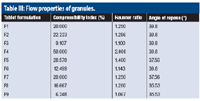
Table III: Flow properties of granules.
The 80-mg tablet formulations containing Methocel K15M CR showed significant water penetration (i.e., 17%) that enabled the tablet to dissolve, whereas formulations containing HPC showed only 1–4% water penetration. The metronidazole formulation containing Methocel K15M CR and Carbomer 934P had a floating lag time of less than 300 s. Formulations using HPC had no buoyancy after 8 h. Formulations containing Methocel K15M CR had floating time of 4 h, and Carbomer 934P had a floating time of 8 h (see Table I).
Tablets' floating capacity depends on the density of the system, the quantity of the gas-generating agents (i.e., NaHCO3 and citric acid), and the concentration of polymers. Table I shows the floating lag time of the tablets. The tablets formulated with Methocel K15M CR and Carbomer 934P became buoyant after 5 min of contact with the dissolution medium, but the HPC-containing tablets did not show any buoyancy after 8 h.
The in vitro drug release was best described by the Higuchi kinetic model, and its highest linearity was R2 = 0.903. These results confirmed that the drugs were released by a combination of diffusion and erosion (see Table IV).
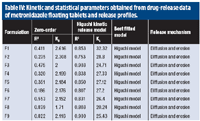
Table IV: Kinetic and statistical parameters obtained from drug-release data of metronidazole floating tablets and release profiles.
The floating behavior and percentage release of the metronidazole tablets also were investigated. F1 tablets had a total floating time of 4.20 h. F7 tablets had a floating time of 7 h, and F8 and F9 tablets had a floating time of 8 h. This difference may occur because NaHCO3 forms gas quickly and citric acid reduces the density of the tablet (i.e., < 1 g/cm3 ). On the other hand, F4, F5, and F6 tablets had no floating ability, perhaps because the system's density was greater than 1 g/cm3 . In addition, HPC may retard the release of carbon-dioxide gas to the system. The buoyancy of the tablets formulated with Carbomer 934P lasted for 8 h because this light and porous material helped produce a low-density system. In vitro drug-release profiles present the cumulative percent release of drug against time (see Figures 1–3). F1 tablets released about 70–93% drug. All other tablets had released about 71% drug after 8 h. No drug–drug or drug–excipient interactions were found, hence 100% release of metronidazole may be achieved with further experiments.
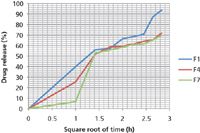
Figure 1: In vitro drug-release profiles of F1, F4, and F7 drug formulations.
All sustained-release formulations have rate-controlling mechanisms, such as swelling, diffusion, and erosion (13). The Higuchi kinetic model best described the drug release from these tablets, which depended on the concentration of polymers. F1 tablets, which contained only 40 mg of Methocel K15M CR, had the highest release of drug (i.e., 93.69%). Buoyancy in F1 tablets lasted 4.20 h and was decreased by increasing the amount of Methocel K15M CR. Also, the release of drug increased at first, then gradually decreased with time by the diffusion mechanism. F7, F8, and F9 tablets formulated with Carbomer 934P released approximately 71% of the drug. These conditions might have caused rapid hydration of Carbomer matrices, gel formation, swelling, and diffusion, which increased the release duration of metronidazole.
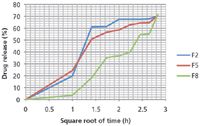
Figure 2: In vitro drug-release profiles of F2, F5, and F8 drug formulations.
F2 and F3 tablets released the drug rapidly (i.e., 1 and 2 h, respectively). A possible reason is that Methocel K15M CR increases the surface area to expose the deposited drug to the dissolution medium. The drug-release profile is important in describing bioavailability and in optimizing controlled release. The release of metronidazole from the tablets was based on non-Fickian diffusion and the concentration of the rate-controlling polymers (14). Asnaashari et al. showed that a high amount of rate-controlling polymer provided sufficient floating ability and release in formulations with two or more polymers (15). The authors' experimental results showed that drug release was almost 93.69% using 40 mg of Methocel K15M CR and 70% using Carbomer 934P. Buoyancy of F1 and F9 tablets lasted 4.20 h and 8 h, respectively, with no combinations of polymers.
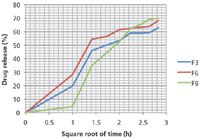
Figure 3: In vitro drug-release profiles of F3, F6, and F9 drug formulations.
Conclusion
These results, in combination with those of previously published reports, justify the use of rate-controlling polymers such as Methocel K15M CR, HPC, and Carbomer 934P to develop metronidazole floating-matrix tablets. The results suggest that a metronidazole-based floating drug-delivery system using a low amount of polymers could reduce the cost of pharmaceutical production and the likelihood of adverse effects. Such a formulation may maintain the specific plasma concentration and local action against H. pylori for peptic ulcer disease, and further studies could improve the formulation's clinical efficiency.
References
1. A.A. Deshpande et al., Pharm. Res. 14 (6), 815–819 (1997).
2. F. Stops et al., Int. J. Pharm. 308 (1–2), 8–13 (2006).
3. F. Stops et al., Int. J. Pharm. 308 (1–2), 14–24 (2006).
4. S.C. Sweetman, "Biowaiver Monographs for Immediate Release Solid Oral Dosage Forms: Metronidazole," in The Complete Drug Reference, C.F. Rediguieri et al., Eds. (Pharmaceutical Press, London, 36th ed., 2009), pp. 837–841.
5. J.S. Simms-Cendan, J. Infect. Dis. 3 (5), 153–156 (1996).
6. J.W. Tracy and L.T. Webster, Jr., "Drugs Used in the Chemotherapy of Protozoal Infections," in The Pharmacological Basis of Therapeutics, J.G. Hardman, L.E. Limbird, and A.G. Gilman, Eds. (McGraw-Hill, New York, 10th ed., 2001), pp. 1105–1109.
7. K.C. Lamp et al., Clin. Pharmacokinet. 36 (5), 353–373 (1999).
8. E.D. Ralph et al., Antimicrob. Agents Chemother. 6 (6), 691–696 (1974).
9. B.N. Singh and K.H. Kim, J. Control Release 63 (3), 235–259 (2000).
10. S. Burton et al., J. Pharm. Pharmacol. 47 (11), 901–906 (1995).
11. V. Alvisi et al., Drugs Exp. Clin. Res. 22 (1), 29–33 (1996).
12. M. Rahman et al., J. Pharmaceutics Cosmetol. 1 (2), 81–92 (2011).
13. M.D. Chavanpatil et al., Int. J. Pharm. 316 (1–2), 86–92 (2006).
14. T. Higuchi, J. Pharm. Sci. 52 (12), 1145–1149 (1963).
15. S. Asnaashari et al., Pharm. Dev. Technol. 16 (4), 1–8 (2010).
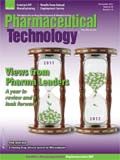
Pharmaceutical Tariffs Are Imminent: How Industry is Bracing for Impact
April 16th 2025On April 14, 2025, the Trump Administration launched a national security-driven investigation into pharmaceuticals, a move that will likely result in tariffs being placed on pharmaceutical drugs, ingredients, and other components that are imported from outside of the United States.
Drug Solutions Podcast: A Closer Look at mRNA in Oncology and Vaccines
April 30th 2024In this episode fo the Drug Solutions Podcast, etherna’s vice-president of Technology and Innovation, Stefaan De Koker, discusses the merits and challenges of using mRNA as the foundation for therapeutics in oncology as well as for vaccines.